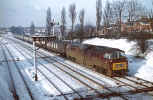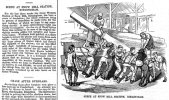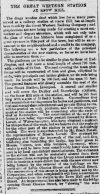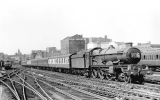Yes you are quite right. If I recall correctly the earliest ones were the 6-car Midland Pullman trains running between St Pancras and Manchester Central. The Birmingham Pullman sets used the same powercars but there were two extra coaches in the consist, making it an 8-car set. I understand they proved to be quite noisy and a bit rough riding, so not quite the luxury trains they were intended to be. I certainly recall seeing one set on the scrap lines at Swindon in 1973.There was more than one Blue Pulman set of units and it was part of the development of higher speed passenger services using internal combustion rather than electricity. Some were Western Region and others were Midland Region.
None were preserved.
-
Welcome to this forum . We are a worldwide group with a common interest in Birmingham and its history. While here, please follow a few simple rules. We ask that you respect other members, thank those who have helped you and please keep your contributions on-topic with the thread.
We do hope you enjoy your visit. BHF Admin Team
You are using an out of date browser. It may not display this or other websites correctly.
You should upgrade or use an alternative browser.
You should upgrade or use an alternative browser.
Snow Hill Station
- Thread starter Alf
- Start date
paul stacey
master brummie
Brilliant video, really nostalgic bought a host of memories long forgotten and hidden, thank you so much for posting!!
Dumb Brummie
proper brummie kid
Great video especially the colour section best station in Birmingham all gone now apart from the new one1960s Snow Hill (silent)
Richard Dye
master brummie
Steam locos we’re like a giant magnet for SCP many of us!1960s Snow Hill (silent)
paul stacey
master brummie
What wonderful tapes, many thanks for posting, brings back such happy , remembrances, and feeling of being young again, simply great !!!
mw0njm.
A Brummie Dude
Western Region D1046 'Western Marquis' is seen at the head of a Pullman express leaving Acocks Green station on 7th January 1963. When the Blue Pullman' was not available, as with the 1:00pm Birmingham Snow Hill to Paddington service, a locomotive hauling Pullman stock would be substituted, known locally as 'the Wells Fargo' set. Built by Crewe works in December 1962, 'Western Marquis' was withdrawn in November 1976 from Laira (LA) to be scrapped by Swindon works. Later assigned by British Rail as Class 52 locomotives, some seventy-four of these large Type 4 diesel-hydraulic locomotives were built for the Western Region of British Railways between 1961 and 1964. All were given two-word names, the first word being 'Western' and thus the type became known as Westerns


Heartland
master brummie
Some facts about the early Snow Hill station deserve to be highlighted and Derek Harrisons' book on the station did not help.
As previously stated the station began as a joint station between two companies that had been taken over by the Great Western Railway and so at the time of opening it was Great Western-owned, but the opening of this station was in two parts. The first was the line to Oxford and the other later to Wolverhampton. The later second date was in 1854 and occupied a rectangular plot of land bounded by Monmouth Street, Livery Street, Great Charles Street, and Snow Hill. A principal entrance was on the Livery Street side.
The track was mixed gauge, broad gauge (7ft 0 1/4 in) and standard gauge (4ft 8 1/2 in) and there were two main platforms with a shorter
platform (between them) which seem to have been reached by a board crossing. The crossing over Great Charles Street was done through three iron bridges (side by side) designed by I K Brunel which carried the tracks northwards.
Following the removal of the broad gauge, the Great Western Railway arranged for the reconstruction of the station creating a station with a longer overall roof. Derek Harrison has said that the original station building being sent to Didcot needs to be questioned with particular regard to what, if anything was removed in that way.
The station that most people remember was that made later by the Great Western which was part of of an extensible reconstruction at the start of the twentieth century where the track was quadrupled from Snow Hill to Handsworth, Moor Street Station was made and from Moor Street, the track was quadrupled as far as Olton. The North Warwickshire line was also made from Tyseley through to Bearley to meet up with the existing branch to Stratford upon Avon. The original locomotive sheds at Bordesley were replaced by the new depot at Tyseley. Post First World War 1 the GWR made further quadrupling work from Olton to Lapworth.
As previously stated the station began as a joint station between two companies that had been taken over by the Great Western Railway and so at the time of opening it was Great Western-owned, but the opening of this station was in two parts. The first was the line to Oxford and the other later to Wolverhampton. The later second date was in 1854 and occupied a rectangular plot of land bounded by Monmouth Street, Livery Street, Great Charles Street, and Snow Hill. A principal entrance was on the Livery Street side.
The track was mixed gauge, broad gauge (7ft 0 1/4 in) and standard gauge (4ft 8 1/2 in) and there were two main platforms with a shorter
platform (between them) which seem to have been reached by a board crossing. The crossing over Great Charles Street was done through three iron bridges (side by side) designed by I K Brunel which carried the tracks northwards.
Following the removal of the broad gauge, the Great Western Railway arranged for the reconstruction of the station creating a station with a longer overall roof. Derek Harrison has said that the original station building being sent to Didcot needs to be questioned with particular regard to what, if anything was removed in that way.
The station that most people remember was that made later by the Great Western which was part of of an extensible reconstruction at the start of the twentieth century where the track was quadrupled from Snow Hill to Handsworth, Moor Street Station was made and from Moor Street, the track was quadrupled as far as Olton. The North Warwickshire line was also made from Tyseley through to Bearley to meet up with the existing branch to Stratford upon Avon. The original locomotive sheds at Bordesley were replaced by the new depot at Tyseley. Post First World War 1 the GWR made further quadrupling work from Olton to Lapworth.
Pedrocut
Master Barmmie
The book by Derek, Salute to Snow Hill : the rise and fall of Birmingham's Snow Hill railway station, 1852-1977, can be read using the Internet Archive.
The Illustrated Midland News, April 1870 gives a description of the scene…

The Birmingham Daily Post, April 1870, gives some insight to the new development.

The Illustrated Midland News, April 1870 gives a description of the scene…

The Birmingham Daily Post, April 1870, gives some insight to the new development.

Rod Liddiard
All Systems Go.
I have photographs og King Class 4-6-0's being used.I seem to remember that when the Blue Pullman set was not available for any reason they used to provide
a Class 52 (Western Hydraulic) with a proper rake of Pullmans, very smart indeed...
Thank you so much for posting this. Too much of my youth spent on the platforms at Snow Hill instead of doing homework! I wondered if I would see myself on the platform but I noticed that the two appearances of 7029 'Clun Castle' were from a time when the locomotive had a single chimney, which dates the film clip(s) to before October 1959, a bit before the time I was allowed out on my own.1960s Snow Hill (silent)
Richard Dye
master brummie
I was never sure what I liked more watching the locos or getting the numbers/spot! I do remember standing on the end of the platform trying to decide is I was going to spend my bus fare on another cup of hot chocolate or ride the bus.Thank you so much for posting this. Too much of my youth spent on the platforms at Snow Hill instead of doing homework! I wondered if I would see myself on the platform but I noticed that the two appearances of 7029 'Clun Castle' were from a time when the locomotive had a single chimney, which dates the film clip(s) to before October 1959, a bit before the time I was allowed out on my own.
As I recall the HC tasted so good on a cold day!
Great times forever!
paul stacey
master brummie
what a wonderful piece of footage, from a great old place of my childhood and youth, so nostalgic, and full of atmosphere, brings back so many memories to an old man !!
mw0njm.
A Brummie Dude
you are welcome. BiscayneThank you so much for posting this. Too much of my youth spent on the platforms at Snow Hill instead of doing homework! I wondered if I would see myself on the platform but I noticed that the two appearances of 7029 'Clun Castle' were from a time when the locomotive had a single chimney, which dates the film clip(s) to before October 1959, a bit before the time I was allowed out on my own.
i like to look at the vid it brings back the mems of when i was 6 and one saturday morning we was a bit late for the train to wooten wawen where we fished ever sat morning. as we ran down the stairs to the platform 11 the driver was waiting for us and shouted "can't you bloody get up in a mornings"
Last edited:
Thank you Biscayne for such wonderful footage. It brought back many happy memories of train spotting on Snow Hill Station in mid to late 1950's.
Me and my friends caught a local stopping GWR train at Soho & Winson Green station for a few old pennies excitally alighting at the station . I was surprised not to see not much traditional brown and cream GWR livery on the carriages. Seemed to be more LMS colours and 60,000 /70,000 engines rather than GWR Kings, Halls and Granges of the time?
Me and my friends caught a local stopping GWR train at Soho & Winson Green station for a few old pennies excitally alighting at the station . I was surprised not to see not much traditional brown and cream GWR livery on the carriages. Seemed to be more LMS colours and 60,000 /70,000 engines rather than GWR Kings, Halls and Granges of the time?
Richard Dye
master brummie
Those were far simpler days Paul, if we think about how many places we would go on our own at a very young age and not worry about any let alone safety!what a wonderful piece of footage, from a great old place of my childhood and youth, so nostalgic, and full of atmosphere, brings back so many memories to an old man !!
Off topic, I found a photo of me just before my 16th birthday cycling in Devon. When I showed my wife she said “how did your mother know where you were” if you did not call her daily? They were the GOOD old DAYS!
Richard Dye
master brummie
Ah, that smell! You knew when you were in the right place.hot oil and steam mix what a great smell
mw0njm.
A Brummie Dude
i still get that smell when the wind is blowing my way from the local steam railwayhot oil and steam mix what a great smell
paul stacey
master brummie
Booked "Clun Castl"e a few times at snow hill, a regular visitor , and always a great sight!!
mw0njm.
A Brummie Dude
I like to see photos of trains as much for the surrounding buildings as the train itself. I enjoy exploring the setting, like in Pete's previous post. They're often views of places you're otherwise unlikely to see. I think the Taylor Challen building still exits but the skyline today bears no - or at least very little - comparison. Viv.
paul stacey
master brummie
I agree Viv, its really interesting to look at the, people as well.
A similar photo in colour with a different train is on post 952 at https://birminghamhistory.co.uk/forum/index.php?threads/snow-hill-station.2793/page-48#post-762841
mw0njm.
A Brummie Dude
former Western Region V (Reading, Didcot, Bristol, Plymouth, Penzance)

 en.wikipedia.org
en.wikipedia.org
scot-rail.co.uk » Headcodes Explained
www.scot-rail.co.uk

Train reporting number - Wikipedia
Genmac1; It was mw0njm who posted the original link to the YouTube video, not me. I used to catch a DMU from Chester Road to New Street, then Shank's pony to Snow Hill. But this was 1965 - 1968 and most locos were diesel by then, just the odd steam freight train or SLS special. Best spot was Cookham Manor, I don't recall the exact date.Thank you Biscayne for such wonderful footage. It brought back many happy memories of train spotting on Snow Hill Station in mid to late 1950's.
Me and my friends caught a local stopping GWR train at Soho & Winson Green station for a few old pennies excitally alighting at the station . I was surprised not to see not much traditional brown and cream GWR livery on the carriages. Seemed to be more LMS colours and 60,000 /70,000 engines rather than GWR Kings, Halls and Granges of the time?
The latest issue of Back Track Magazine (February) has an article, with photos of various dates, entitled "Summer Saturday at Birmingham Snow Hill 1965. The Final Flourish of a Much Loved Station" In addition to a survey of events observed on 28th august 1965, it describes the history and decline of the station

